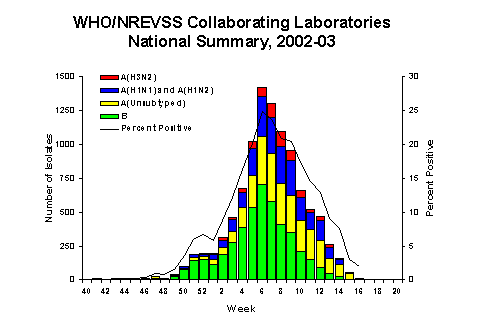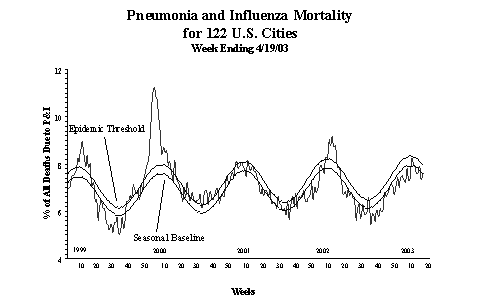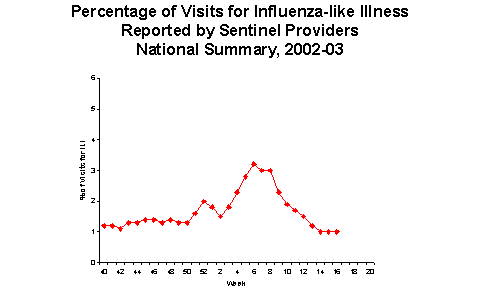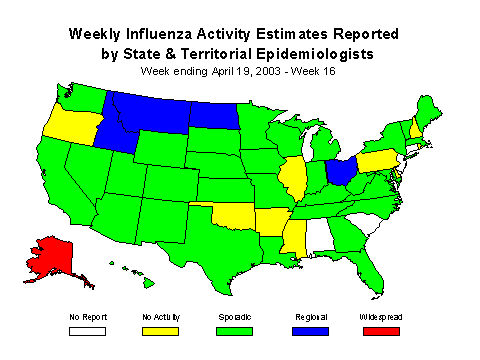Error processing SSI file
Error processing SSI file
Weekly Report: Influenza Summary Update
Week ending April 19, 2003-Week 16
Error processing SSI fileThe following information may be quoted:
Synopsis
During week 16 (April 13-19, 2003)*, 12 (2.0%) of the specimens tested by U.S. World Health Organization (WHO) and National Respiratory and Enteric Virus Surveillance System (NREVSS) collaborating laboratories were positive for influenza. The proportion of patient visits to sentinel providers for influenza-like illness (ILI) overall was 1.0%, which is below the national baseline of 1.9%. The proportion of deaths attributed to pneumonia and influenza was 7.6%. One state and territorial health department reported widespread influenza activity, 4 reported regional activity, 32 reported sporadic activity, and 9 reported no influenza activity**.
Laboratory Surveillance*
During week 16, U.S. WHO and NREVSS laboratories reported 600 specimens tested for influenza viruses, of which 12 (2.0%) were positive. Two influenza A (H1)† viruses, five unsubtyped influenza A viruses, and five influenza B virus were identified. During the past 3 weeks (weeks 14-16), 22.7% of the specimens tested for influenza in the New England region*** were positive. Between 6.2% and 10.3% of the specimens tested for influenza during the past 3 weeks in the Pacific, Mountain, West North Central, and East North Central regions were positive, and less than 3.0% of the specimens tested for influenza during the past 3 weeks in the East South Central, West South Central, Mid-Atlantic, and South Atlantic regions were positive.
Since September 29, WHO and NREVSS laboratories have tested a total of 88,142 specimens for influenza viruses and 10,148 (11.5%) were positive. Of the 10,148 viruses identified, 5,647 (56%) were influenza A viruses and 4,501 (44%) were influenza B viruses. Two thousand eight hundred and seventeen (50%) of the 5,647 influenza A viruses have been subtyped; 2,196 (78%) were influenza A (H1)† viruses and 621 (22%) were influenza A (H3N2) viruses. Influenza A viruses were reported more frequently than influenza B viruses (range 57% - 87%) in the New England, East North Central, Mountain, Pacific, and Mid-Atlantic regions, and influenza B viruses were reported more frequently than influenza A viruses (range 58% - 80%) in the West North Central, West South Central, South Atlantic, and East South Central regions. However, during the past 3 weeks (weeks 14-16), influenza A viruses were reported more frequently than influenza B viruses in all nine surveillance regions.

Antigenic Characterization of Viral Isolates
CDC has antigenically characterized 532 influenza viruses submitted by U.S. laboratories since September 29: two hundred and twenty-eight influenza A (H1)† viruses, 82 influenza A (H3N2) viruses, and 222 influenza B viruses. One hundred and forty of the influenza A (H1) viruses had the N1 neuraminidase, 46 had the N2 neuraminidase, and the neuraminidase typing for 42 H1 viruses is pending. The hemagglutinin proteins of all 228 influenza A (H1) viruses were similar antigenically to the hemagglutinin of the vaccine strain A/New Caledonia/20/99 (H1N1). Of the 82 influenza A (H3N2) isolates that have been characterized, 75 (91%) were similar to A/Panama/2007/99, the H3N2 component of the 2002-03 influenza vaccine, and 7 (9%) showed reduced titers to ferret antisera produced against A/Panama/2007/99. Of the 222 influenza B viruses that have been characterized, 221 belonged to the B/Victoria lineage and were similar antigenically to the vaccine strain B/Hong Kong/330/01 and one belonged to the B/Yamagata lineage and was similar to B/Shizuoka/15/01, a B/Sichuan/379/99-like virus.
Click here for more information about influenza A (H1N2) viruses
Composition of the 2003-04 Influenza Vaccine
The Food and Drug Administration’s Vaccine and Related Biological Products Advisory Committee recommended that the 2003-04 trivalent influenza vaccine for the United States contain A/New Caledonia/20/99-like (H1N1), A/Moscow/10/99-like (H3N2), and B/Hong Kong/330/2001-like viruses. All 3 components (H1N1, H3N2, and B) are the same as those for the 2002-03 season vaccine. This recommendation was based on antigenic analyses of recently isolated influenza viruses, epidemiologic data, and post-vaccination serologic studies in humans.
Pneumonia and Influenza (P&I) Mortality Surveillance
During week 16, the percentage of all deaths due to pneumonia and influenza as reported by the vital statistics offices of 122 U.S. cities was 7.6%. This percentage is below the epidemic threshold of 7.9% for week 16.

Influenza-like Illness Surveillance *
During week 16, 1.0% of patient visits to U.S. sentinel providers were due to ILI. This percentage is below the national baseline of 1.9%. On a regional level***, the percentage of visits for ILI ranged from 0.0% to 2.0%. Due to wide variability in regional level data, it is not appropriate to apply the national baseline to regional level data.

Influenza Activity as Assessed by State and Territorial Epidemiologists**
Influenza activity was reported as widespread
in Alaska, and regional in 4 states (Idaho, Montana, North
Dakota, and Ohio). Thirty-two states and New York City
reported sporadic activity, and 9 states reported no influenza
activity. Four states and Washington, D.C. did not report.

* Reporting is incomplete for this week. Numbers may change as more reports are received.
** Influenza activity is defined as influenza-like illness and/or culture-confirmed influenza.
†Includes both the A (H1N1) and A (H1N2) influenza virus subtypes. The influenza A (H1N2) strain appears to have resulted from the reassortment of the genes of currently circulating influenza A (H1N1) and A (H3N2) subtypes. Because the hemagglutinin proteins of the A (H1N2) viruses are similar to those of the currently circulating A (H1N1) viruses and the neuraminidase proteins are similar to those of the currently circulating A (H3N2) viruses, the 2002-03 influenza vaccine should provide protection against A (H1N2) viruses.
*** Surveillance Regions: New England (Connecticut, Maine, Massachusetts, New Hampshire, Vermont, Rhode Island); Mid-Atlantic (New Jersey, New York City, Pennsylvania, Upstate New York); East North Central (Illinois, Indiana, Michigan, Ohio, Wisconsin); West North Central (Iowa, Kansas, Minnesota, Missouri, Nebraska, North Dakota, South Dakota); South Atlantic (Delaware, Florida, Georgia, Maryland, North Carolina, South Carolina, Virginia, Washington, D.C., West Virginia); East South Central (Alabama, Kentucky, Mississippi, Tennessee); West South Central (Arkansas, Louisiana, Oklahoma, Texas); Mountain (Arizona, Colorado, Idaho, Montana, Nevada, New Mexico, Utah, Wyoming); Pacific (Alaska, California, Hawaii, Oregon, Washington)
Report prepared April 24, 2003
Error processing SSI file